2009 Seat Ibiza ST ignition
[x] Cancel search: ignitionPage 181 of 250

Checking and refilling levels
180
WARNING
All work on the engine or in the engine compartment, e.g. checking and
refilling fluids, involves the danger of injury and scalding as well as the risk
of accident or fire.•Never open the bonnet if you see steam, smoke or coolant escaping
from the engine compartment. Otherwise, there is a risk of sustaining
burns. Wait until no more steam or coolant is emitted, then allow the
engine to cool before carefully opening the bonnet.•Switch off the engine and remove the key from the ignition.•Apply the handbrake and move the gear lever to neutral or gear lever to
position P.•Keep children away from the vehicle.•Never touch hot engine parts. There is a risk of burns.•Never spill liquids on a hot engine or on a hot exhaust gas system. This
is a fire hazard.•Avoid causing short-circuits in the electrical system, particularly at the
points where the jump leads are attached ⇒page 223. The battery could
explode.•Never touch the radiator fan. It is temperature controlled and could
start automatically, even when the engine has been switched off and the
key removed from the ignition!•Do not unscrew the cap on the expansion tank when the engine is hot.
If the coolant is hot, the cooling system will be pressurised!•Protect face, hands and arms by covering the cap with a large, thick
cloth to protect against escaping coolant and steam.•Al wa ys m ake s u re yo u ha ve n o t l e f t a ny o bj e c t s , s u ch as cl e an i n g cl o t h s
and tools, in the engine compartment.•If you have to work underneath the vehicle, you must use suitable
stands additionally to support the vehicle, there is a risk of accident!. A
hydraulic jack is insufficient for securing the vehicle and there is a risk of
injury.
•If any work has to be performed when the engine is started or with the
engine running, there is an additional, potentially fatal, safety risk from the
rotating parts, such as the drive belts, alternator, radiator fan, etc., and
from the high-voltage ignition system. You should also observe the
following points:
−Never touch the electrical wiring of the ignition system.
− Ensure that jewellery, loose clothing and long hair do not get
trapped in rotating engine parts. Danger of death. Before starting any
work remove jewellery, tie back and cover hair, and wear tight-fitting
clothes.
− Always think carefully about pressing the accelerator if a gear is
engaged in either an automatic or manual gearbox. The vehicle could
move, even if the handbrake is applied. Danger of death.•If work has to be carried out on the fuel system or on electrical compo-
nents, you must observe the following safety notes in addition to the above
warnings:
−Always disconnect the battery. The vehicle must be unlocked when
this is done, otherwise the alarm will be triggered.
− Do not smoke.
− Never work near naked flames.
− Always have a fire extinguisher on hand.Caution
When changing or topping up service fluids, make absolutely certain that you
fill the fluids into the correct reservoirs. Failure to observe this point will result
in serious malfunctions and engine damage!
WARNING (continued)
Ibiza ST_EN.book Seite 180 Dienstag, 12. Januar 2010 4:03 16
Page 190 of 250
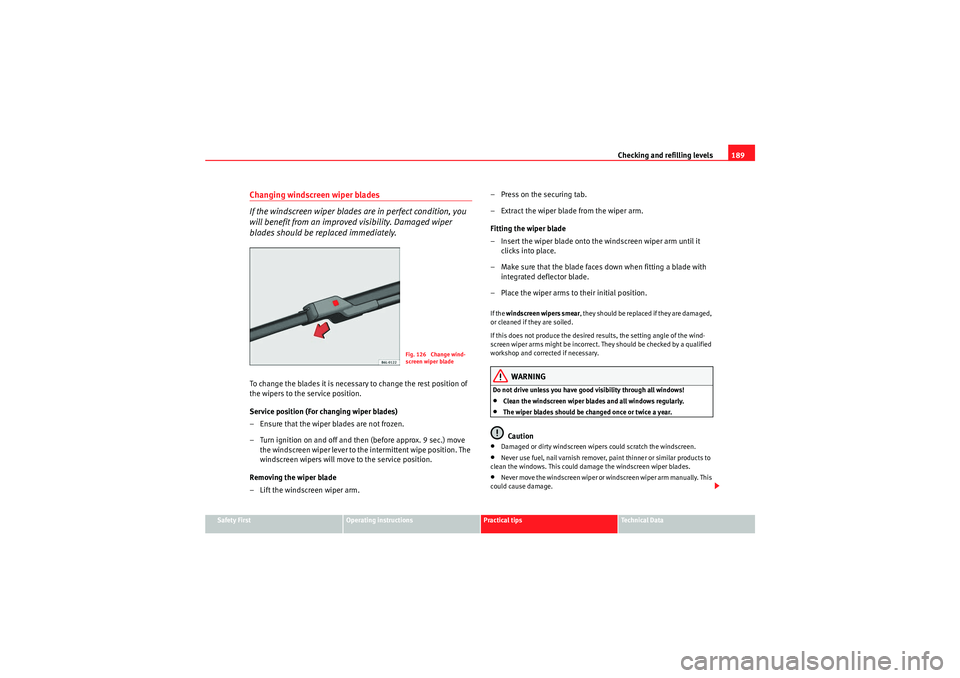
Checking and refilling levels189
Safety First
Operating instructions
Practical tips
Technical Data
Changing windscreen wiper blades
If the windscreen wiper blades are in perfect condition, you
will benefit from an improved visibility. Damaged wiper
blades should be replaced immediately.To change the blades it is necessary to change the rest position of
the wipers to the service position.
Service position (For changing wiper blades)
– Ensure that the wiper blades are not frozen.
– Turn ignition on and off and then (before approx. 9 sec.) move
the windscreen wiper lever to the intermittent wipe position. The
windscreen wipers will move to the service position.
Removing the wiper blade
– Lift the windscreen wiper arm. – Press on the securing tab.
– Extract the wiper blade from the wiper arm.
Fitting the wiper blade
– Insert the wiper blade onto the windscreen wiper arm until it
clicks into place.
– Make sure that the blade faces down when fitting a blade with integrated deflector blade.
– Place the wiper arms to their initial position.
If the windscreen wipers smear , t h e y s h o u l d b e r e p la ce d i f t h e y a r e d a m a ge d ,
or cleaned if they are soiled.
If this does not produce the desired results, the setting angle of the wind-
screen wiper arms might be incorrect. They should be checked by a qualified
workshop and corrected if necessary.
WARNING
Do not drive unless you have good visibility through all windows!•Clean the windscreen wiper blades and all windows regularly.•The wiper blades should be changed once or twice a year.Caution
•Damaged or dirty windscreen wipers could scratch the windscreen.•Never use fuel, nail varnish remover, paint thinner or similar products to
clean the windows. This could damage the windscreen wiper blades.•Never move the windscreen wiper or windscreen wiper arm manually. This
could cause damage.
Fig. 126 Change wind-
screen wiper blade
Ibiza ST_EN.book Seite 189 Dienstag, 12. Januar 2010 4:03 16
Page 194 of 250
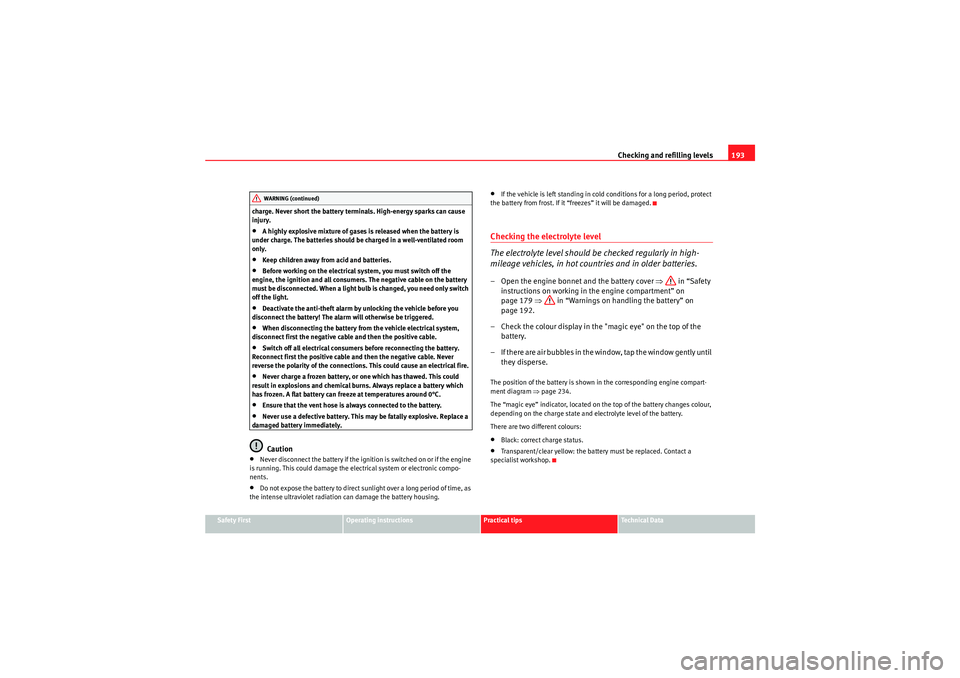
Checking and refilling levels193
Safety First
Operating instructions
Practical tips
Technical Data
charge. Never short the battery terminals. High-energy sparks can cause
injury.
•A highly explosive mixture of gases is released when the battery is
under charge. The batteries should be charged in a well-ventilated room
only.•Keep children away from acid and batteries.•Before working on the electrical system, you must switch off the
engine, the ignition and all consumers. The negative cable on the battery
must be disconnected. When a light bulb is changed, you need only switch
off the light.•Deactivate the anti-theft alarm by unlocking the vehicle before you
disconnect the battery! The alarm will otherwise be triggered.•When disconnecting the battery from the vehicle electrical system,
disconnect first the negative cable and then the positive cable.•Switch off all electrical consumers before reconnecting the battery.
Reconnect first the positive cable and then the negative cable. Never
reverse the polarity of the connections. This could cause an electrical fire.•Never charge a frozen battery, or one which has thawed. This could
result in explosions and chemical burns. Always replace a battery which
has frozen. A flat battery can freeze at temperatures around 0°C.•Ensure that the vent hose is always connected to the battery.•Never use a defective battery. This may be fatally explosive. Replace a
damaged battery immediately.Caution
•Never disconnect the battery if the ignition is switched on or if the engine
is running. This could damage the electrical system or electronic compo-
nents.•Do not expose the battery to direct sunlight over a long period of time, as
the intense ultraviolet radiation can damage the battery housing.
•If the vehicle is left standing in cold conditions for a long period, protect
the battery from frost. If it “freezes” it will be damaged.Checking the electrolyte level
The electrolyte level should be checked regularly in high-
mileage vehicles, in hot countries and in older batteries.– Open the engine bonnet and the battery cover ⇒ in “Safety
instructions on working in the engine compartment” on
page 179 ⇒ in “Warnings on handling the battery” on
page 192.
– Check the colour display in the "magic eye" on the top of the battery.
– If there are air bubbles in the window, tap the window gently until they disperse.The position of the battery is shown in the corresponding engine compart-
ment diagram ⇒page 234.
The “magic eye” indicator, located on the top of the battery changes colour,
depending on the charge state and electrolyte level of the battery.
There are two different colours:•Black: correct charge status.•Transparent/clear yellow: the battery must be replaced. Contact a
specialist workshop.
WARNING (continued)
Ibiza ST_EN.book Seite 193 Dienstag, 12. Januar 2010 4:03 16
Page 210 of 250

If and when209
Safety First
Operating instructions
Practical tips
Technical Data
Tyre repair
The following sections describe the procedures for repairing
a tyre.Using the sealing compound
– The instructions on the container give detailed information on
how to use the sealing compound.
Inflating the tyre.
– Remove the air compressor and hose from the container.
– Screw the retaining nut onto the valve.
– Plug the compressor cable into a 12 volt power point.
– Turn on compressor and monitor the pressure shown on the pres- sure gauge.
Completing the repair
– Remove the compressor hose from the valve.
– Fit the valve cap.
– Unplug the compressor from the socket.
– Return all tools to their proper storing location.
NoteThe compressor should never be allowed to run for longer than 6 minutes.
FusesChanging a fuse
Blown fuses must be replacedFuse cover
– Switch off the ignition and its failed electrical component.
– Identify the fuse corresponding to the damaged electric consumer ⇒page 210.
– Take the plastic clip from inside the fuse cover, fit it onto the blown fuse and pull the fuse out.
– Replace the blown fuse (which will have a melted metal strip) with a new fuse of the same ampere rating.
Fig. 137 Fuses in the
dash panel
Ibiza ST_EN.book Seite 209 Dienstag, 12. Januar 2010 4:03 16
Page 224 of 250
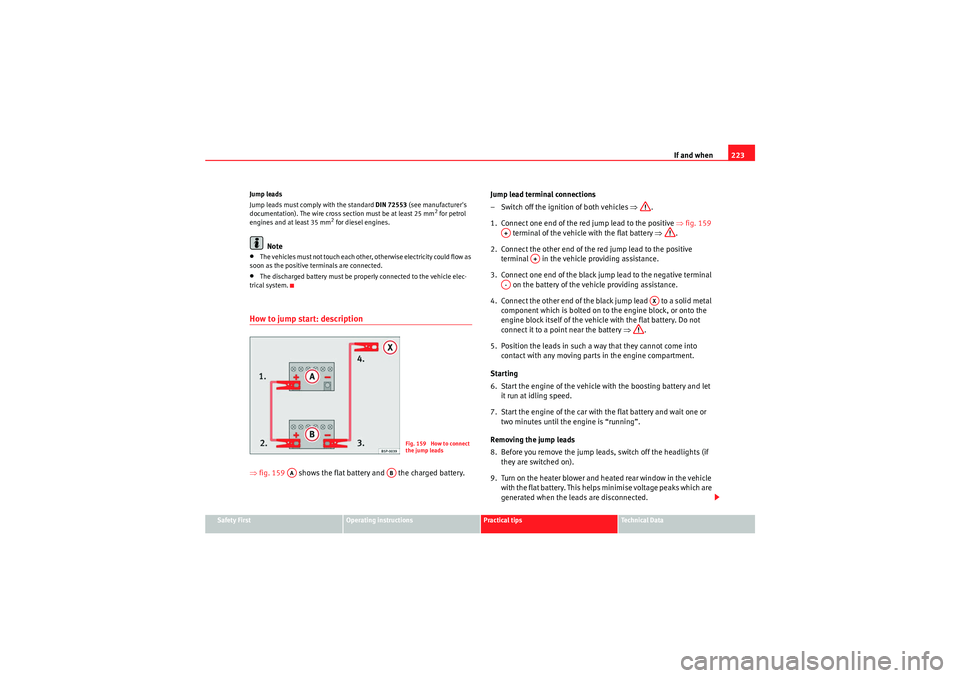
If and when223
Safety First
Operating instructions
Practical tips
Technical Data
Jump leads
Jump leads must comply with the standard
DIN 72553 (see manufacturer's
documentation). The wire cross section must be at least 25 mm
2 for petrol
engines and at least 35 mm
2 for diesel engines.
Note
•The vehicles must not touch each other, otherwise electricity could flow as
soon as the positive terminals are connected.•The discharged battery must be properly connected to the vehicle elec-
trical system.How to jump start: description⇒ fig. 159 shows the flat battery and the charged battery. Jump lead terminal connections
– Switch off the ignition of both vehicles
⇒.
1. Connect one end of the red jump lead to the positive ⇒fig. 159
terminal of the vehicle with the flat battery ⇒.
2. Connect the other end of the red jump lead to the positive terminal in the vehicle providing assistance.
3. Connect one end of the black jump lead to the negative terminal on the battery of the vehicle providing assistance.
4. Connect the other end of the black jump lead to a solid metal component which is bolted on to the engine block, or onto the
engine block itself of the vehicle with the flat battery. Do not
connect it to a point near the battery ⇒.
5. Position the leads in such a way that they cannot come into contact with any moving parts in the engine compartment.
Starting
6. Start the engine of the vehicle with the boosting battery and let it run at idling speed.
7. Start the engine of the car with the flat battery and wait one or two minutes until the engine is “running”.
Removing the jump leads
8. Before you remove the jump leads, switch off the headlights (if they are switched on).
9. Turn on the heater blower and heated rear window in the vehicle with the flat battery. This helps minimise voltage peaks which are
generated when the leads are disconnected.
Fig. 159 How to connect
the jump leads
AA
AB
A+
A+
A-
AX
Ibiza ST_EN.book Seite 223 Dienstag, 12. Januar 2010 4:03 16
Page 226 of 250

If and when225
Safety First
Operating instructions
Practical tips
Technical Data
Towing and tow-startingTo w - s t a r t i n g *
The use of jump leads is pr eferable to tow-starting.We recommend that you do not tow-start your vehicle. Jump-starting
is preferable ⇒page 222.
However, if your vehicle has to be tow-started:
– Engage the 2
nd or the 3
rd gear.
– Keep the clutch pressed down.
– Switch the ignition on.
– Once both vehicles are moving, release the clutch.
– As soon as the engine starts, press the clutch and move the gear lever into neutral. This helps to prevent driving into the towing
vehicle.
WARNING
The risk of accidents is high when tow-starting. The vehicle being towed
can easily collide with the towing vehicle.
Caution
When tow-starting, fuel could enter the catalytic converter and damage it.
CommentsPlease observe the following po ints if you use a tow-rope:
Notes for the driver of the towing vehicle
– Drive slowly at first until the tow-rope is taut. Then accelerate gradually.
– Begin and change gears cautiously. If you are driving an auto- matic vehicle, accelerate gently.
– Remember that the brake servo and power steering are not working in the vehicle you are towing. Brake earlier than you
would normally, but with a more gentle pressure on the brake.
Notes for the driver of the towed vehicle
– Ensure that the tow-rope remains taut at all times when towing.Tow-rope or tow-bar
It is easier and safer to tow a vehicle with a tow-bar. You should only use a
tow-rope if you do not have a tow-bar.
A tow-rope should be slightly elastic to reduce the loading on both vehicles.
It is advisable to use a tow-rope made of synthetic fibre or similarly elastic
material.
Attach the tow-rope or the tow-bar only to the towing eyes provided or a
towing bracket.
Driving style
Towing requires some experience, especially when using a tow-rope. Both
drivers should be familiar with the technique required for towing. Inexperi-
enced drivers should not attempt to tow-start or tow away another vehicle.
Ibiza ST_EN.book Seite 225 Dienstag, 12. Januar 2010 4:03 16
Page 227 of 250
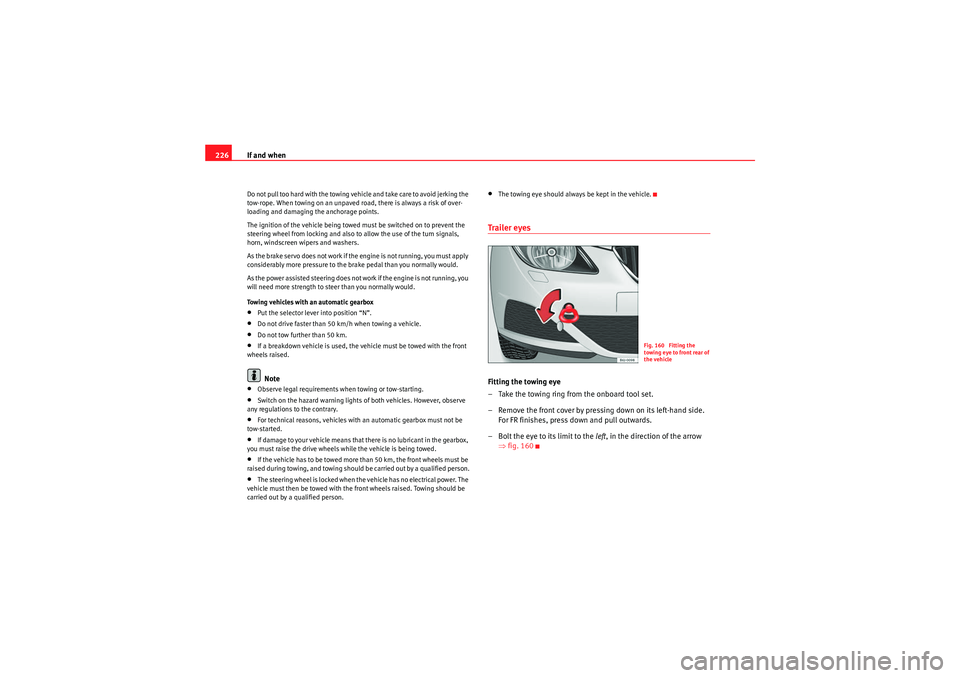
If and when
226Do not pull too hard with the towing vehicle and take care to avoid jerking the
tow-rope. When towing on an unpaved road, there is always a risk of over-
loading and damaging the anchorage points.
The ignition of the vehicle being towed must be switched on to prevent the
steering wheel from locking and also to allow the use of the turn signals,
horn, windscreen wipers and washers.
As the brake servo does not work if the engine is not running, you must apply
considerably more pressure to the brake pedal than you normally would.
As the power assisted steering does not work if the engine is not running, you
will need more strength to steer than you normally would.
Towing vehicles with an automatic gearbox•Put the selector lever into position “N”.•Do not drive faster than 50 km/h when towing a vehicle.•Do not tow further than 50 km.•If a breakdown vehicle is used, the vehicle must be towed with the front
wheels raised.Note
•Observe legal requirements when towing or tow-starting.•Switch on the hazard warning lights of both vehicles. However, observe
any regulations to the contrary.•For technical reasons, vehicles with an automatic gearbox must not be
tow-started.•If damage to your vehicle means that there is no lubricant in the gearbox,
you must raise the drive wheels while the vehicle is being towed.•If the vehicle has to be towed more than 50 km, the front wheels must be
raised during towing, and towing should be carried out by a qualified person.•The steering wheel is locked when the vehicle has no electrical power. The
vehicle must then be towed with the front wheels raised. Towing should be
carried out by a qualified person.
•The towing eye should always be kept in the vehicle.Trailer eyesFitting the towing eye
– Take the towing ring from the onboard tool set.
– Remove the front cover by pressing down on its left-hand side. For FR finishes, press down and pull outwards.
– Bolt the eye to its limit to the left, in the direction of the arrow
⇒ fig. 160
Fig. 160 Fitting the
towing eye to front rear of
the vehicle
Ibiza ST_EN.book Seite 226 Dienstag, 12. Januar 2010 4:03 16
Page 245 of 250
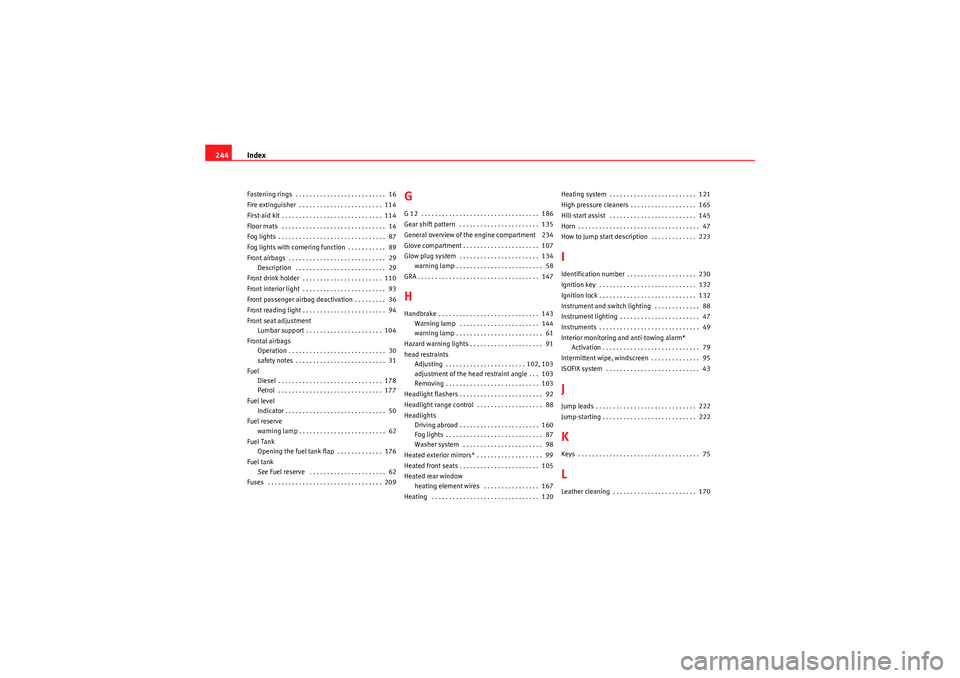
Index
244Fastening rings . . . . . . . . . . . . . . . . . . . . . . . . . . 16
Fire extinguisher . . . . . . . . . . . . . . . . . . . . . . . . 114
First-aid kit . . . . . . . . . . . . . . . . . . . . . . . . . . . . . 114
Floor mats . . . . . . . . . . . . . . . . . . . . . . . . . . . . . . 14
Fog lights . . . . . . . . . . . . . . . . . . . . . . . . . . . . . . . 87
Fog lights with cornering function . . . . . . . . . . . 89
Front airbags . . . . . . . . . . . . . . . . . . . . . . . . . . . . 29
Description . . . . . . . . . . . . . . . . . . . . . . . . . . 29
Front drink holder . . . . . . . . . . . . . . . . . . . . . . . 110
Front interior light . . . . . . . . . . . . . . . . . . . . . . . . 93
Front passenger airbag deactivation . . . . . . . . . 36
Front reading light . . . . . . . . . . . . . . . . . . . . . . . . 94
Front seat adjustment Lumbar support . . . . . . . . . . . . . . . . . . . . . . 104
Frontal airbags Operation . . . . . . . . . . . . . . . . . . . . . . . . . . . . 30
safety notes . . . . . . . . . . . . . . . . . . . . . . . . . . 31
Fuel Diesel . . . . . . . . . . . . . . . . . . . . . . . . . . . . . . 178
Petrol . . . . . . . . . . . . . . . . . . . . . . . . . . . . . . 177
Fuel level Indicator . . . . . . . . . . . . . . . . . . . . . . . . . . . . . 50
Fuel reserve warning lamp . . . . . . . . . . . . . . . . . . . . . . . . . 62
Fuel Tank Opening the fuel tank flap . . . . . . . . . . . . . 176
Fuel tank See Fuel reserve . . . . . . . . . . . . . . . . . . . . . . 62
Fuses . . . . . . . . . . . . . . . . . . . . . . . . . . . . . . . . . 209
GG 12 . . . . . . . . . . . . . . . . . . . . . . . . . . . . . . . . . . 186
Gear shift pattern . . . . . . . . . . . . . . . . . . . . . . . 135
General overview of the engine compartment 234
Glove compartment . . . . . . . . . . . . . . . . . . . . . . 107
Glow plug system . . . . . . . . . . . . . . . . . . . . . . . 134 warning lamp . . . . . . . . . . . . . . . . . . . . . . . . . 58
GRA . . . . . . . . . . . . . . . . . . . . . . . . . . . . . . . . . . . 147HHandbrake . . . . . . . . . . . . . . . . . . . . . . . . . . . . . 143 Warning lamp . . . . . . . . . . . . . . . . . . . . . . . 144
warning lamp . . . . . . . . . . . . . . . . . . . . . . . . . 61
Hazard warning lights . . . . . . . . . . . . . . . . . . . . . 91
head restraints Adjusting . . . . . . . . . . . . . . . . . . . . . . . 102, 103
adjustment of the head restraint angle . . . 103
Removing . . . . . . . . . . . . . . . . . . . . . . . . . . . 103
Headlight flashers . . . . . . . . . . . . . . . . . . . . . . . . 92
Headlight range control . . . . . . . . . . . . . . . . . . . 88
Headlights Driving abroad . . . . . . . . . . . . . . . . . . . . . . . 160
Fog lights . . . . . . . . . . . . . . . . . . . . . . . . . . . . 87
Washer system . . . . . . . . . . . . . . . . . . . . . . . 98
Heated exterior mirrors* . . . . . . . . . . . . . . . . . . . 99
Heated front seats . . . . . . . . . . . . . . . . . . . . . . . 105
Heated rear window heating element wires . . . . . . . . . . . . . . . . 167
Heating . . . . . . . . . . . . . . . . . . . . . . . . . . . . . . . 120 Heating system . . . . . . . . . . . . . . . . . . . . . . . . . 121
High pressure cleaners . . . . . . . . . . . . . . . . . . . 165
Hill-start assist . . . . . . . . . . . . . . . . . . . . . . . . . 145
Horn . . . . . . . . . . . . . . . . . . . . . . . . . . . . . . . . . . . 47
How to jump start description . . . . . . . . . . . . . 223
IIdentification number . . . . . . . . . . . . . . . . . . . . 230
Ignition key . . . . . . . . . . . . . . . . . . . . . . . . . . . . 132
Ignition lock . . . . . . . . . . . . . . . . . . . . . . . . . . . . 132
Instrument and switch lighting . . . . . . . . . . . . . 88
Instrument lighting . . . . . . . . . . . . . . . . . . . . . . . 47
Instruments . . . . . . . . . . . . . . . . . . . . . . . . . . . . . 49
Interior monitoring and anti-towing alarm*
Activation . . . . . . . . . . . . . . . . . . . . . . . . . . . . 79
Intermittent wipe, windscreen . . . . . . . . . . . . . . 95
ISOFIX system . . . . . . . . . . . . . . . . . . . . . . . . . . . 43JJump leads . . . . . . . . . . . . . . . . . . . . . . . . . . . . . 222
Jump-starting . . . . . . . . . . . . . . . . . . . . . . . . . . . 222KKeys . . . . . . . . . . . . . . . . . . . . . . . . . . . . . . . . . . . 75LLeather cleaning . . . . . . . . . . . . . . . . . . . . . . . . 170
Ibiza ST_EN.book Seite 244 Dienstag, 12. Januar 2010 4:03 16